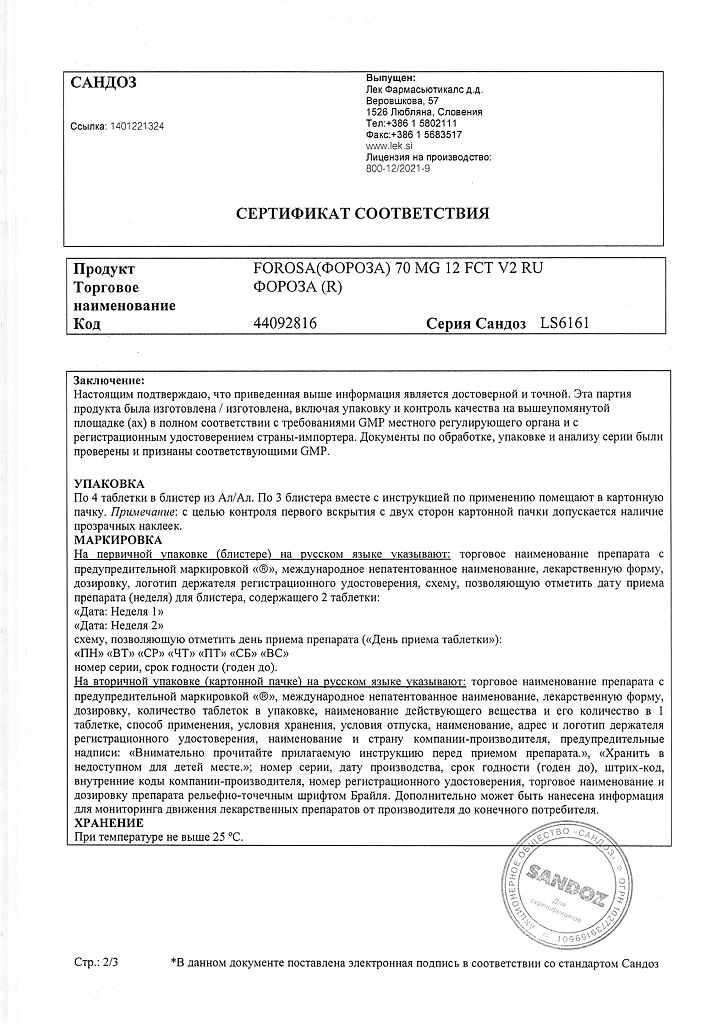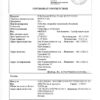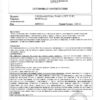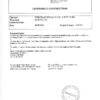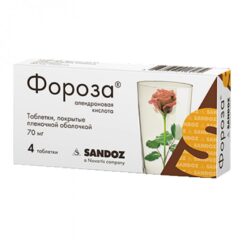No products in the cart.
Forosa, 70 mg 12 pcs
€1.00
Out of stock
(E-mail when Stock is available)
Description
Forose is a non-hormonal specific inhibitor of osteoclastic bone resorption, inhibiting the activity of osteoclasts.
Stimulates osteogenesis, restores positive balance between bone resorption and restoration, increases bone mineral density (regulates phosphorus-calcium exchange), promotes formation of bone tissue with normal histological structure.
Indications
Indications
– Treatment of osteoporosis in postmenopausal women, incl. to reduce the risk of vertebral compression fractures and hip fractures.
– Treatment of osteoporosis in men to prevent fractures.
– Treatment of osteoporosis caused by long-term use of corticosteroids.
Pharmacological effect
Pharmacological effect
Forosa is a non-hormonal specific inhibitor of osteoclastic bone resorption, suppressing the activity of osteoclasts.
Stimulates osteogenesis, restores a positive balance between bone resorption and restoration, increases bone mineral density (regulates phosphorus-calcium metabolism), promotes the formation of bone tissue with a normal histological structure.
Special instructions
Special instructions
The tablets should be taken only with plain water, because… other drinks (including mineral water, tea, coffee, fruit juices) impair the absorption of the drug. Taking alendronate before bed or in a horizontal position increases the risk of developing esophagitis.
Before starting therapy with Forosa, correction of hypocalcemia and other metabolic disorders (such as vitamin D deficiency) is necessary. Due to the increase in bone mineral density during alendronate therapy, a slight clinically asymptomatic decrease in serum calcium and phosphate levels is possible, especially in patients receiving corticosteroids, in whom calcium absorption may be reduced.
Therefore, ensuring that a sufficient amount of calcium and vitamin D enters the body is especially important in patients receiving GCS. Patients should be warned that if they accidentally miss a dose of the drug once a week, they should take 1 tablet in the morning of the next day (it is unacceptable to take 2 tablets in one day). Subsequently, you should continue to take 1 tablet on the day of the week that was chosen at the beginning of therapy.
Osteonecrosis of the jaw has rarely been reported when other bisphosphonates were prescribed. Most cases have been reported in cancer patients during dental procedures, with a few cases in patients with postmenopausal osteoporosis or other diseases. Risk factors for the development of osteonecrosis of the jaw include an established diagnosis of cancer, concomitant therapy (chemotherapy, radiation therapy, corticosteroids) and other disorders (anemia, coagulopathy, infection, gum disease).
Most cases were observed with intravenous administration of bisphosphonates, but isolated cases were observed in patients receiving drugs orally. Dental surgery during bisphosphonate therapy can increase the manifestations of osteonecrosis of the jaw.
It is unknown whether discontinuation of bisphosphonates reduces the risk of osteonecrosis of the jaw. The decision to conduct treatment must be made for each patient individually after assessing the risk/benefit ratio.
Active ingredient
Active ingredient
Alendronic acid
Composition
Composition
1 film-coated tablet contains:
sodium alendronate trihydrate 91.350 mg, which corresponds to the content of alendronic acid 70 mg.
Excipients:
microcrystalline cellulose,
silicon dioxide colloidal anhydrous,
croscarmellose sodium,
magnesium stearate.
Shell composition:
Luster Clear LC 103 (microcrystalline cellulose, carrageenan, macrogol 8000).
Pregnancy
Pregnancy
The drug is contraindicated during pregnancy and breastfeeding.
Contraindications
Contraindications
– Strictures or achalasia of the esophagus and other conditions that lead to slower movement of food through the esophagus.
– Patient’s inability to stand or sit for 30 minutes.
– Hypocalcemia.
– Severe renal failure (creatinine clearance less than 35 ml/min).
– Severe disorders of mineral metabolism.
– Pregnancy.
– Lactation period (breastfeeding).
– Children’s age (efficacy and safety of use have not been established).
– Hypersensitivity to alendronate or other components of the drug.
The drug should be prescribed with caution to patients with:
– Gastrointestinal diseases: dysphagia, gastritis, duodenitis, peptic ulcer in the acute stage, active gastrointestinal bleeding or a history of surgery on the upper gastrointestinal tract.
– Hypovitaminosis D.
Interaction
Interaction
Concomitant use of calcium supplements (including dietary supplements) and antacids impairs the absorption of alendronate.
In this regard, it is recommended to take other medications no earlier than 30 minutes after taking Forosa.
NSAIDs (including acetylsalicylic acid) may increase the gastrointestinal side effects of alendronic acid.
Although specific drug interaction studies have not been conducted, the use of alendronate in clinical studies with a large number of commonly used drugs was not accompanied by the development of clinically significant interactions.
Overdose
Overdose
Symptoms: abdominal pain, dyspeptic disorders, dysphagia, heartburn, esophagitis, gastritis; Hypocalcemia and hypophosphatemia may develop.
Treatment: symptomatic.
The use of milk and antacids to bind alendronate is indicated. Due to the risk of damage to the esophagus, vomiting should not be induced and the patient should be in an upright position.
Storage conditions
Storage conditions
In a dry place, protected from light, at a temperature not exceeding 25 °C
Shelf life
Shelf life
3 years
Manufacturer
Manufacturer
Lek d.d., Slovenia
Additional information
| Shelf life | 3 years |
|---|---|
| Conditions of storage | In a dry, light-protected place at a temperature not exceeding 25 °C |
| Manufacturer | Lek d.d., Slovenia |
| Medication form | pills |
| Brand | Lek d.d. |
Other forms…
Related products
Buy Forosa, 70 mg 12 pcs with delivery to USA, UK, Europe and over 120 other countries.



